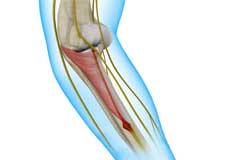
What is Radial Tunnel Syndrome?
Radial tunnel syndrome is a painful condition caused by pressure on the radial nerve in the forearm. The entrapment or compression occurs frequently in the proximal forearm in the radial tunnel, a narrow space through which the nerve runs near the elbow joint. The radial nerve emerges from the C5-C8 and T1 spinal nerves. It is one of the three major nerves of the arm that supplies the hand muscles helping in movement and sensation of the hand and wrist.
Symptoms
Symptoms include a dull aching pain in the forearm, which can radiate to the back of your hand or to the outside of the elbow. Pain worsens when you straighten your arm or finger. You may also experience weakness of your hand and wrist and decreased ability to grip objects.
Causes
Compression of the radial nerve can be caused by:
- Bone tumors
- Trauma to the nerve
- Repetitive or overuse injuries
- Inflammation of surrounding tissue
- Health conditions such as thyroid problems and diabetes
Diagnosis
- Your doctor will review your medical history and perform a thorough physical examination of your elbow.
- Electrodiagnostic tests such as electromyography and nerve conduction studies may be used in determining how well the nerve is functioning and locate areas of nerve compression.
- Imaging studies such as X-ray or MRI may be used to aid in the diagnosis.
Treatment
Non-surgical Treatment
Your treatment plan may include the following options:
- Non-steroidal anti-inflammatory drugs (NSAIDs) to manage pain and inflammation.
- Applying ice packs over a towel to the involved area to help reduce swelling and pain.
- Avoid pressure on the nerve by not leaning on the elbow.
- Wearing a brace or splint at night while sleeping may be recommended.
- Avoid activities that tend to bring on the symptoms.
- Steroid injections may be administered to reduce pain and inflammation.
- Occupational therapy may be recommended for improving flexibility, range of motion and strength-building.
Surgery
Surgery may be recommended if you do not respond to non-surgical treatment options. The goal of the surgery is to reduce the pressure on the radial nerve by providing more space for the nerve to move freely and to increase blood flow for the nerve to heal.
The most common surgery is radial tunnel release procedure that is performed under regional or general anesthesia. The muscles causing compression are identified and incised to create more space for the nerve. A bulky dressing with or without a plaster splint is usually applied following surgery. Occupational therapy may be ordered after surgery to help with flexibility and strength.
Related Topics
- Triceps Injuries
- Osteochondritis Dissecans of the Capitellum
- Elbow Trauma
- Elbow Arthritis
- Bicep Tendon Tear at the Elbow
- Elbow Dislocation
- Triceps Tendonitis
- Elbow (Olecranon) Bursitis
- Elbow Sprain
- Tennis Elbow
- Golfer's Elbow
- Little League Elbow
- Nursemaid's Elbow
- Elbow Pain
- Elbow Contracture
- Distal Humerus Fractures of the Elbow
- Radial Head Fractures of the Elbow
- Elbow Fractures
- Ulnar Nerve Neuropathy
- Loose Bodies in the Elbow
- Radial Tunnel Syndrome
- Lateral Ulnar Collateral Ligament Injuries (Elbow)
- Post-traumatic Stiffness (Elbow)
- Cubital Tunnel Syndrome (Ulnar Nerve Entrapment)





